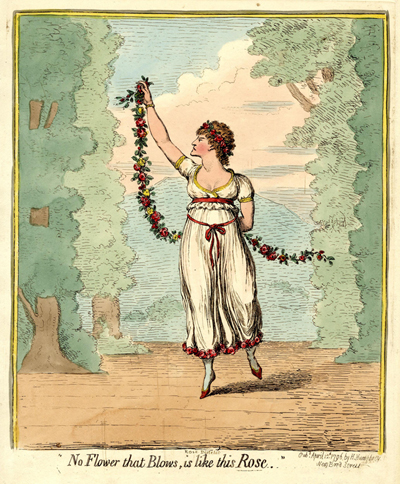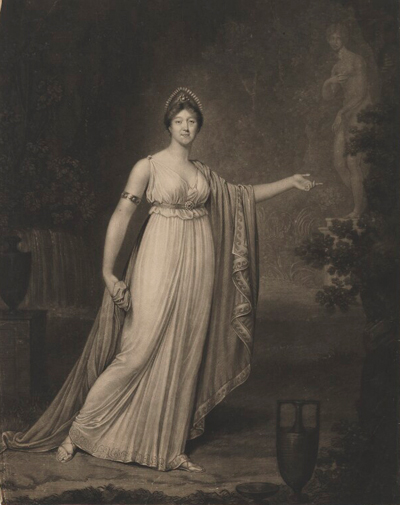'No flower that blows, is like this rose'
Gillray loved to catch the attention of his audience by titles that referenced the popular culture of his day, including theatre, art, song, and news. So it comes as no surprise that the title of this print is the first line of a well-known song, "No Flower that Blows" by Thomas Linley. It is also the "clue" that identifies this portrait caricature as the famous French dancer Rose Didelot (née Pole or Paul). This is the first of three prints that Gillray devotes to Rose. The others are Modern Grace, or the Operatical Finale to the Ballet of Alonzo e Caro (May 5, 1796) and Operatical Reform, or la Dance a l'Eveque (March 14, 1798).

© Trustees of the British Museum
Madame Rose, as she was sometimes called, was part of a world famous husband and wife ballet duo recently arrived from France as one of the leading attractions at the King's Theatre where a couple of other stars, Mademoiselle Parisot and Marie-Louise Hilligsberg were already appearing. Rose and her husband, Charles, who was both a lead male dancer and choreographer, were widely anticipated by lovers of ballet.
The mania of expectation was on Saturday night at the very acme of curiosity. The Pit was so crowded, even before the drawing up of the curtain, that it was not possible to edge another face into the area. Stars, garters, feathers, and turbans were so jumbled and intermixed at the doors that all sex and identity were undistinguishable. The stage itself, was crammed on all sides, and in such a manner as to render the shifting of the scenery 'a work of labour, and a service of danger.' So eager indeed was the desire of seeing DIDELOT and ROSE that the wings were crowded with Ladies. (London Times, 22 February, 1796)
They were also highly paid. The Monthly Mirror for the first of February reported that they were receiving 3000 Guineas for their first five month season.
Based on an amateur drawing in the British Museum collection that has not yet been digitized, Madame Rose is shown dancing alone on stage with her head turned to reveal a rather severe profile. She is wearing the high waisted and clinging empire style dress that was, like the Didelots themselves, a popular French export in 1796. As the war with revolutionary France dragged on, however, the French nationality and semi-diaphanous dress of the female ballet dancers would eventually attract unwanted negative attention from the Bishop of Durham.
The features recorded in No Flower that Blows are certainly very different from the slightly earlier formal portrait of Madame Rose while she was still in France.

Madame Rose Didelot in an Empire Style Dress
[1790s]
© National Portrait Gallery, London
Sources and Reading
- Commentary from the British Museum on 'No flower that blows, is like this rose'.
- "Thomas Linley," Wikisource
- "Charles Didelot," Wikipedia
- "Didelot," A Biographical Dictionary of Actors, Actresses, Musicians, Dancers, Managers ...
- Thomas Wright and Joseph Grego, The Works of James Gillray, the Caricaturist; With the History of His Life and Times, p. 211.
Comments & Corrections
NOTE: Comments and/or corrections are always appreciated. To make that easier, I have included a form below that you can use. I promise never to share any of the info provided without your express permission.